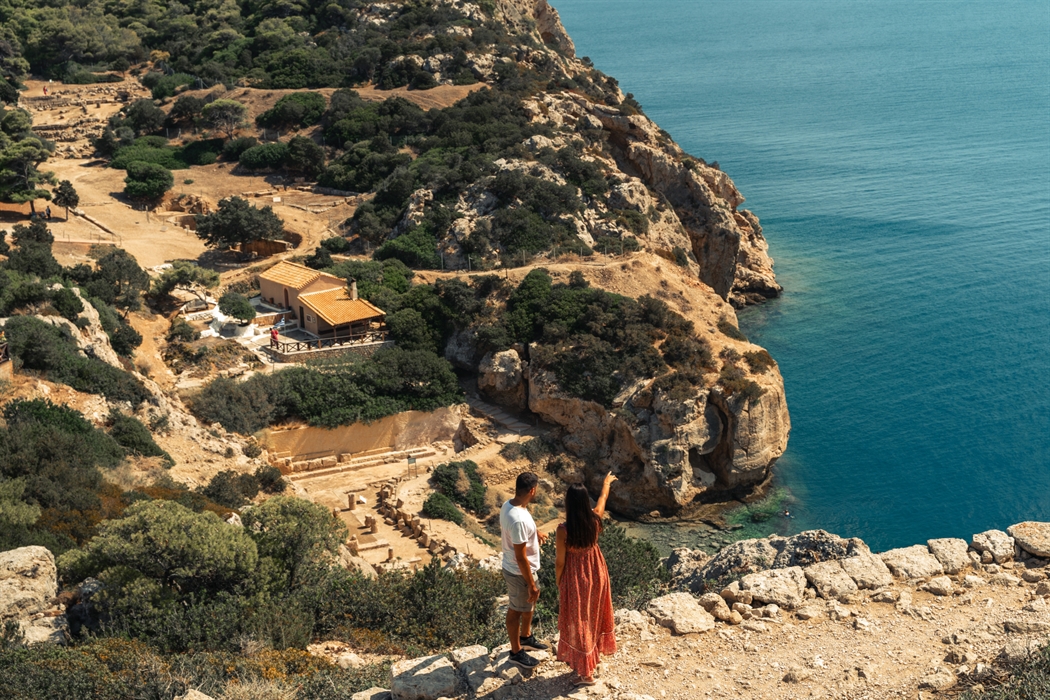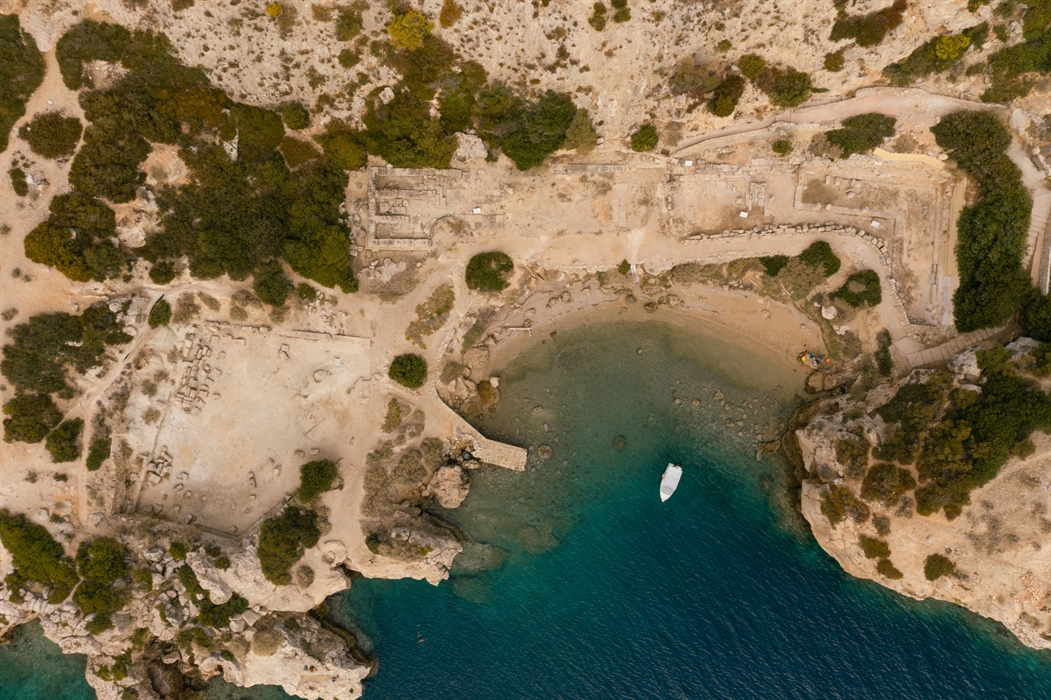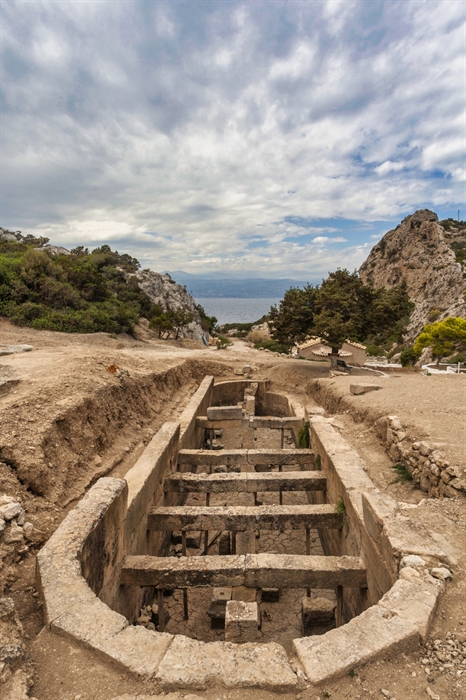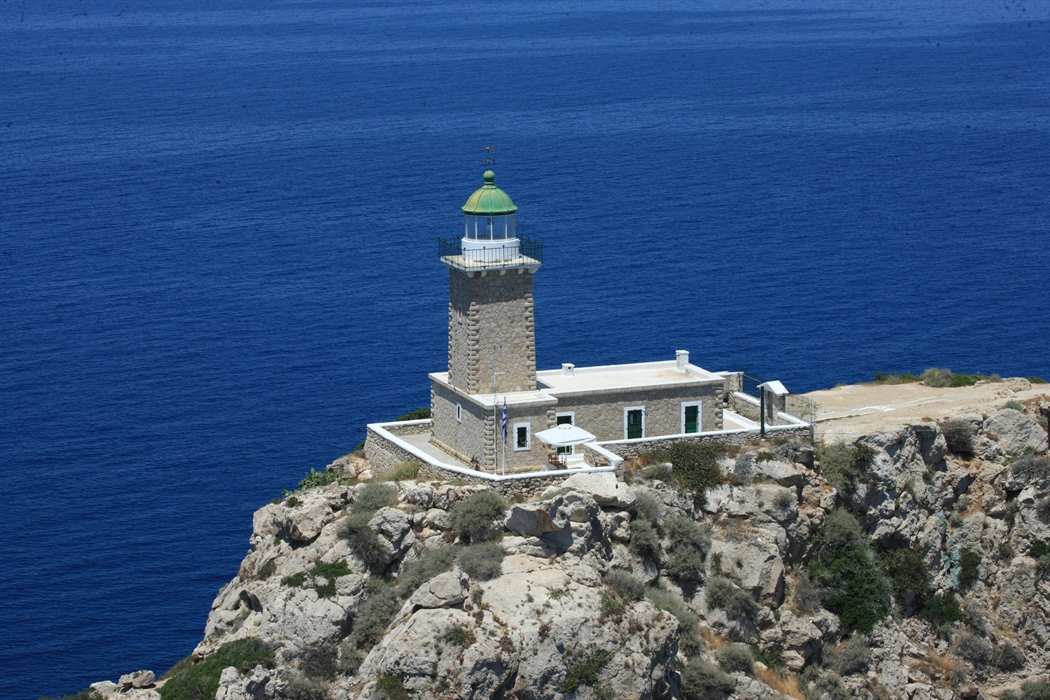Heraion of Perachora
Many Greek archaeological sites have impressive settings, but the Perachora Heraion has a magic all of its own. Part of the ancient ruins are at the edge of a beautiful cove and you can admire them also when you swim. On top of that, you are only a few minutes’ walk from the Cape Melagavi lighthouse and only a few kilometres to the west of the Vouliagmeni lagoon, making this a great day-trip for anyone who is in the area.
The Perachora peninsula ends at Cape Melagavi just a few kilometers to the west of the Vouliagmeni lagoon. There, right beside the sea, you will find the remains of what was once one of the most important places of worship in Corinthia. This combination of the sparkling clear sea, the sheltered harbour and the evocative ruins of the ancient temple make this a uniquely lovely place to visit.
The archaeological site covers quite a large area and is divided into three levels: 1. The port area with the Temple of Hera Akraia, the altar and the two-storied Stoa. 2. The aspidal cistern and the dining rooms. 3. The area with the dining room building, homes and part of the extensive water collection system.
The sanctuary is thought to have been founded by the Megarians and then came under the control of the Corinthians later. When the Corinthians were setting out to find new colonies over the Adriatic Sea, they would stop here to make offerings to the goddess Hera.
The first temple was built here in the Geometric era (825-800 BC) but was completely destroyed. It was replaced in the late 6th century by a Doric style temple, with a cella (inner chamber) where a statue of the goddess Hera stood. This new temple was built a few meters to the west of the geometrical temple, and the older temple’s site was occupied by an altar which was built for ritual sacrifices. The two-story stoa building was also in the port area. The ground floor colonnade was Doric and the upper floor was Ionic, something that makes the monument an important example of early Greek architecture. It was probably used to keep votive offerings and as somewhere for guests to sit.
The site grew gradually over the years until it covered three levels and included the dining room, where dignitaries’ official meals were held, and the Sacred Pool. It seems that visitors to the site took part in purification rituals in the pool, as flasks and pitchers used in these rites have been discovered here.
During the Archaic era the site was one of the most important places of worship in Corinthia. It had widespread influence and people travelled here from all over Greece, as can be seen from the tributes from Argolida, Laconia, Rhodes, Chios and Attica that were discovered here.
The Heraion continued to flourish in the 4th century BC as it was not badly damaged during the Spartan raid on the area. Fairly extensive alterations and additions were made to the site around this time, including the dining rooms (which were initially thought to be the Temple of Hera Limenia) and a complex, innovative and impressive irrigation system.
However, the site did not escape the attentions of the Romans after the Battle of Corinth (146 BC) when the Romans defeated the Corinthians and their allies and then completely destroyed the city. The site was plundered by the Roman legions and was no longer used as a place of worship. The area was possibly inhabited again during the period of Roman rule in Greece (31 BC-324 AD), but over the centuries it was abandoned.
Although the site was first excavated in the 1930s, the wider area was only declared a demarcated archaeological site in 1991. Nowadays there are information boards on the site, and work has been done to make the monuments easier to access and to highlight the ruins and their history.
A wealth of interesting and diverse archaeological finds from the site including small bronze statues, seals, scarabs, ivory pins, jewellery and hundreds of thousands of fragments of painted pottery, etc are on display in the Archaeological Museum of Athens and the Archaeological Museum of Ancient Corinth.
The Cape Melagavi Lighthouse
Watching the sun set from Cape Melagavi Lighthouse is the perfect end to a great day. It’s only a few minutes’ walk from the archaeological site, and there’s a path to the left just before you reach the lighthouse which takes you to a great spot to see the sunset. The stone lighthouse was built in 1897 and, apart from during the Second World War when it was not in use, it has been guiding ships as they sail towards the Corinth Canal since then. It is one of the most beautiful lighthouses in Greece and has been classified as a protected historical monument.
Did you know that
Entrance to the Heraion archaeological site is free. Tel.: 27410 32630.
Location
Find the destination on the interactive map below.
Categories
Σχετικό περιεχόμενο χρηστών (UGC)
Ενημερωθείτε για ενδιαφέροντα θέματα γύρω από τον προορισμό μέσα από το περιεχόμενο των χρηστών μας
Discover 7 hidden gems of the Peloponnese
Many of you may have already visited some of the most renowned attractions…
TOP 10 archaeological museums in the Peloponnese
Olympia, Mycenae, Epidaurus, Diros Cave, Ancient Corinth, Messene and…
TOP 10 Castles in the Peloponnese
Castles galore! Mystras, Monemvasia, Palamidi, Methoni, Koroni,…
Newsletters
- About us
- FAQ's
- Map
- Tourism information centers
- Disclaimer
- Sitemap
- Our brand
- Media roum
- Adding your bussiness
- Corporate
- MICE

Peloponnese. Greece beyond the obvious





Design and creation from Cosmote
Marinas and Moorings
Diving centers
Get inspired
- Media gallery
- Blog
- The Peloponnese in the media
- Your feedback
- Users' general content
- Users' local products
- Users' events content
- Ask a local
More
- Accommodation
- Travel agencies
- Restaurants
- Services
- Destinations Map
- Weather
- Public transport
- Events
- Frequently asked questions
- Useful phones
- B2B
- Destination Data
- Contact





